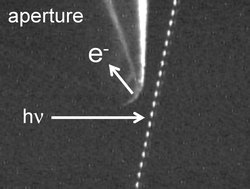A combined droplet train and ambient pressure photoemission spectrometer for the investigation of liquid/vapor interfaces
Abstract
We describe a combined ambient pressure

a
Chemical Sciences Division, Lawrence Berkeley National Laboratory, Berkeley, USA
E-mail:
hbluhm@lbl.gov
Tel: +1 (1)510 486 5431
b Molecular Foundry, Lawrence Berkeley National Laboratory, Berkeley, USA
c Aerodyne Research Inc., Billerica, USA
We describe a combined ambient pressure

 Please wait while we load your content...
Something went wrong. Try again?
Please wait while we load your content...
Something went wrong. Try again?
D. E. Starr, E. K. Wong, D. R. Worsnop, K. R. Wilson and H. Bluhm, Phys. Chem. Chem. Phys., 2008, 10, 3093 DOI: 10.1039/B800717A
To request permission to reproduce material from this article, please go to the Copyright Clearance Center request page.
If you are an author contributing to an RSC publication, you do not need to request permission provided correct acknowledgement is given.
If you are the author of this article, you do not need to request permission to reproduce figures and diagrams provided correct acknowledgement is given. If you want to reproduce the whole article in a third-party publication (excluding your thesis/dissertation for which permission is not required) please go to the Copyright Clearance Center request page.
Read more about how to correctly acknowledge RSC content.
 Fetching data from CrossRef.
Fetching data from CrossRef.
This may take some time to load.
Loading related content
